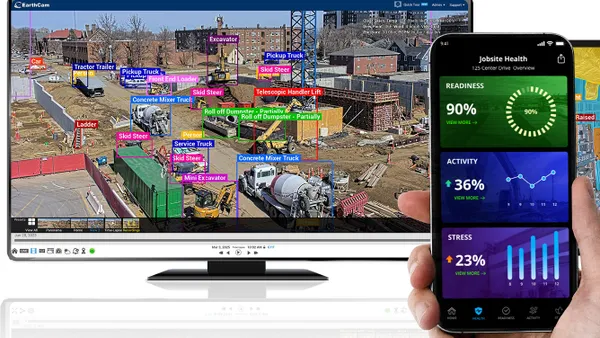Building Information Modeling (BIM) is no longer just a tool to facilitate building design. Instead, it has become a deliverable in and of itself: a comprehensive digital approach that goes beyond 3D modeling to integrate data-rich collaboration, lifecycle management, regulatory compliance and enhanced operational efficiency.
As a deliverable, the digital building model provides all stakeholders with a single source of truth, enabling smarter and more sustainable project delivery and asset management.
Most U.S. firms use BIM as a design and construction tool. Yet few people consider it a deliverable, partly due to the perceived limitations of the technology and the barriers to access across project teams.
“Only a few people even know where the BIM file is,” said Budi Susanto, GM for LeapThought Asia. LeapThought’s FULCRUMHQ is a leading Integrated Digital Delivery platform. “Contractors need to stop just designing in 3D and start building in 3D.”
Government mandates spur BIM adoption
Governments worldwide are recognizing the value of BIM — even mandating its use to improve construction outcomes. These new policies are driving a global shift toward BIM adoption.
For example, Singapore, the United Kingdom, Norway, Finland and Malaysia all have significant BIM mandates to enhance the efficiency and quality of their construction projects.
In the United States, the approach to BIM mandates is fragmented, although several forward-thinking states and localities are taking steps toward adoption. Notable examples include state transportation and facilities agencies in California, Colorado, Ohio, Texas, Virginia and Wisconsin, all of which have implemented BIM requirements or otherwise established BIM protocols for select projects. Even local municipalities are adopting BIM. Broward County, in Florida, has long been a leader in BIM adoption within the U.S. – as one example, the Broward County Aviation Department (BCAD) has developed a flexible BIM standard with clearly defined deliverables, aligning its goals and objectives with the National Building Information Modeling Standard.
The push toward greater BIM adoption within the U.S. is encouraging more contractors there to consider whether and how their processes enable them to optimize the technology.
Integrated Digital Delivery makes the most of BIM
How can contractors worldwide respond to new BIM requirements while efficiently and effectively leveraging BIM for project delivery?
For a growing number of firms, the answer is Integrated Digital Delivery (IDD) — an increasingly popular approach to design and construction that connects all physical and digital aspects of a project into an intelligent common data environment (CDE) that’s easy for all stakeholders to access.
IDD enhances BIM in several ways. Project teams that use IDD experience:
- Better collaboration.
- Smarter process automation.
- Greater transparency.
- Increased data-driven decision-making.
Leveraging IDD, construction teams can access real-time data, streamline workflows and reduce errors — leading to more successful project outcomes. All of these digital connections transform the building model into a deliverable in and of itself, rather than just a tool.
While many AECO firms utilize BIM in their projects, IDD goes beyond simple usage. “Unlike closed systems, best-in-class IDD platforms welcome all your data, regardless of origin. This unlocks a wealth of possibilities,” said Ratnakar Garikipati, LeapThought’s founder and CEO.
Case study: Singapore’s success with BIM and IDD
Singapore, which chose LeapThought’s FULCRUMHQ as its national digital construction platform, stands out as a global leader in BIM and IDD adoption. The country’s Building and Construction Authority (BCA) has been proactive in promoting BIM through initiatives such as the BIM Roadmap and IDD Implementation Plan, harnessing the power of true digital construction.
For contractors, the results translate to outstanding time, efficiency and quality gains including:
- 65% reduction in rework.
- 55% less time monitoring site works and managing projects.
- 50% less time on design coordination approvals.
- 30% less time reviewing and approving documents.
“Singapore’s commitment to BIM and IDD has set a benchmark for the global construction industry. By integrating digital technologies, we are able to deliver projects more efficiently and with greater accuracy," Susanto said.
Making the Shift to BIM as a deliverable
As Singapore demonstrates, using an IDD-centric platform helps teams get more out of BIM, including:
- Improved Outcomes: IDD-enabled BIM leads to better project planning and execution, resulting in higher-quality buildings and infrastructure.
- Cost Savings: By reducing errors and rework, IDD + BIM lowers construction costs.
- Greater Collaboration: BIM supported by an IDD platform fosters collaboration among all project stakeholders, ensuring everyone is on the same page.
To get the benefits that come with BIM as a deliverable, companies must overcome common BIM-related challenges. These include:
- Leadership Commitment: Senior management must align BIM initiatives with strategic goals, allocate necessary resources, drive change management efforts, establish policies and governance, and monitor performance. Singapore serves as an excellent example, where the government’s mandate for BIM in specific construction projects has significantly improved project coordination, efficiency and overall construction quality.
- Learning Curve: Adopting BIM requires training and a mindset shift, which can be challenging for some teams.
- Implementation Costs: The initial investment in BIM software and training can be substantial.
- Data Management: Effective data management is crucial to leverage the full potential of BIM, and this requires robust systems and processes.
Such change management may seem daunting, but it’s less resource-intensive than many fear. “With the right software and the right partner, you’d be very surprised how easy and inexpensive it is to implement IDD,” Garikipati said.
Preparing for Success in the BIM Era
To fully capitalize on the benefits of BIM as a deliverable, construction professionals should:
- Invest in Training and Education: Ensure all team members are well-versed in BIM tools and processes.
- Foster a Collaborative Mindset: Encourage open communication and teamwork among all project stakeholders.
- Embrace Digital Tools and Platforms: Utilize the latest digital technologies to enhance BIM processes.
- Focus on Effective Data Management: Implement robust data management practices to maintain the integrity and accessibility of BIM data.
The global shift toward BIM is gaining momentum. By implementing an IDD platform to support their BIM processes, AEC firms can enable better collaboration, accuracy and efficiency across their project teams and the entire organization.
“It doesn’t have to be an all-or-nothing process,” Garikipati said. “You can begin using IDD for things like submittals and BIM collaboration, and then continue to connect your whole ecosystem over time.”
To learn more about how LeapThought’s FULCRUMHQ Integrated Digital Delivery Platform can help your team make the most of BIM, visit LeapThought.com/FULCRUMHQ.










